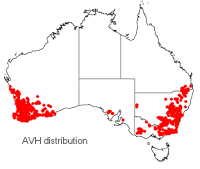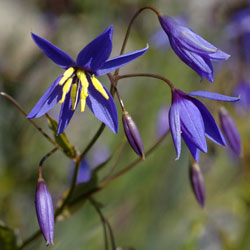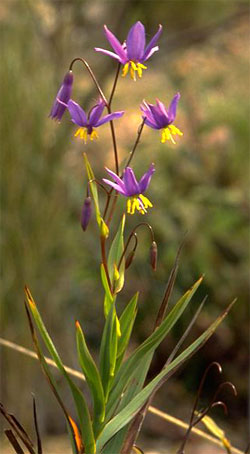Stypandra glauca
Nodding Blue Lily
Stypandra glauca (Nodding Blue Lily) is a member of the family Phormiaceae. Its distribution is widespread from south east Queensland through to Western Australia. A single specimen has also been collected from New Caledonia.  Although quite tolerant of drought it is not found in extremely arid areas. It is not considered to be at risk in the wild; however, very few have been collected in South Australia. Due to its variable characteristics and wide distribution collections have often been incorrectly described as new species. It is now widely accepted that there are two species within the genus Stypandra. Stypandra glauca is the most widely distributed species with S. jamesii endemic to a small area in Western Australia.
Although quite tolerant of drought it is not found in extremely arid areas. It is not considered to be at risk in the wild; however, very few have been collected in South Australia. Due to its variable characteristics and wide distribution collections have often been incorrectly described as new species. It is now widely accepted that there are two species within the genus Stypandra. Stypandra glauca is the most widely distributed species with S. jamesii endemic to a small area in Western Australia.
Although it has the appearance of a shrub, S. glauca is actually a multi stemmed tufted plant. It has long lanceolate leaves which hug the stem. The leaves are generally blue/green in colour, with some variation upon this theme. Older leaves turn brown/black, which gives the plant a striking appearance. It can reach heights between 0.6 and 1.5m. The pretty flowers of S. glauca droop terminally from slender stalks; they are usually blue in colour or occasionally white. The flowers are bisexual with prominent yellow filaments. Flowering occurs in early spring, less often in winter. The fruit is a black capsule and leathery in appearance. Stypandra glauca also reproduces asexually via rhizomes.
Stypandra glauca tolerates drought and frost extremely well, making it a good choice for modern gardens. This perennial plant can survive for many years with nothing more than some basic care. Plantings should be done in a position with good drainage and full to part sunlight. The ideal soils are sandy, granite, shale, limestone or clay. This plant will grow well on a bare plot and it will also tolerate plantings within grasses and herbs that do not overshade it. A good companion plant is Dianella revoluta, also a member of Phormiaceae. Although there are some similarities in the appearance of the flower, the fruit and foliage of these plants are quite different.
Propagation from seed has had variable results. The best results have been found when sowing the seeds directly in the soil outdoors during autumn. Patience is required here as S. glauca has been known to sprout months after being sown. A more reliable way to propagate this plant is to divide up an existing plant and re-plant the divisions in the cooler months when growth has slowed. Divisions should be quite large to increase the chances of survival. Naturally occurring S. glauca tends to thrive after fire. To recreate fire conditions, once a year remove old growth at the base and add fertilisers to the soil.
Stypandra glauca may not be suitable for well manicured gardens as the older growth blackens. This problem can be alleviated with pruning or by planting in amongst other plants. When drought persists there is a tendency for fewer flowers to appear which may also lessen its appeal. With a little watering the flowers should appear on mass, providing a brilliant display of colour. Stypandra glauca looks great in rockeries or natural plantings. The older blacker growth provides a strong contrast in colour with the younger blue/green growth, which is especially attractive when placed against a feature wall.
The plant is found locally in and around Canberra. It is most suited to the local soils and weather; therefore, it will need little attention.
Text by Charlotte Hurry (2007 Botanical Intern)
Name Meaning: Stypandra glaucaStypandra – from the Greek stype for flax fibres and aner man, in reference to the staminal filament hairs which are beard like in appearance. glauca – from the Greek glaukos meaning sea green which refers to the colour of the foliage. |
References
George, A.S. (Ed.) (1987) Flora of Australia Volume 45, Hydatellaceae to Liliaceae, Australian Government Publishing Service, Canberra
Spencer, R. (Ed.) (2005) Horticultural Flora of South Eastern Australia, Flowering Plants – Monocotyledons, University of New South Wales Press Ltd, Sydney
Paczkowska, G. and Chapman, A. R. (2000) The Western Australian Flora - A Descriptive Catalogue, Wildflower Society of Western Australia, Perth
Electronic flora of South Australiahttp://www.flora.sa.gov.au/cgi-bin/texhtml.cgi?form=speciesfacts&genus=Stypandra&species=glauca (Copyright 2001, Last accessed 16 Feb. 07)
![An Australian Government Initiative [logo]](/images/austgovt_brown_90px.gif)



